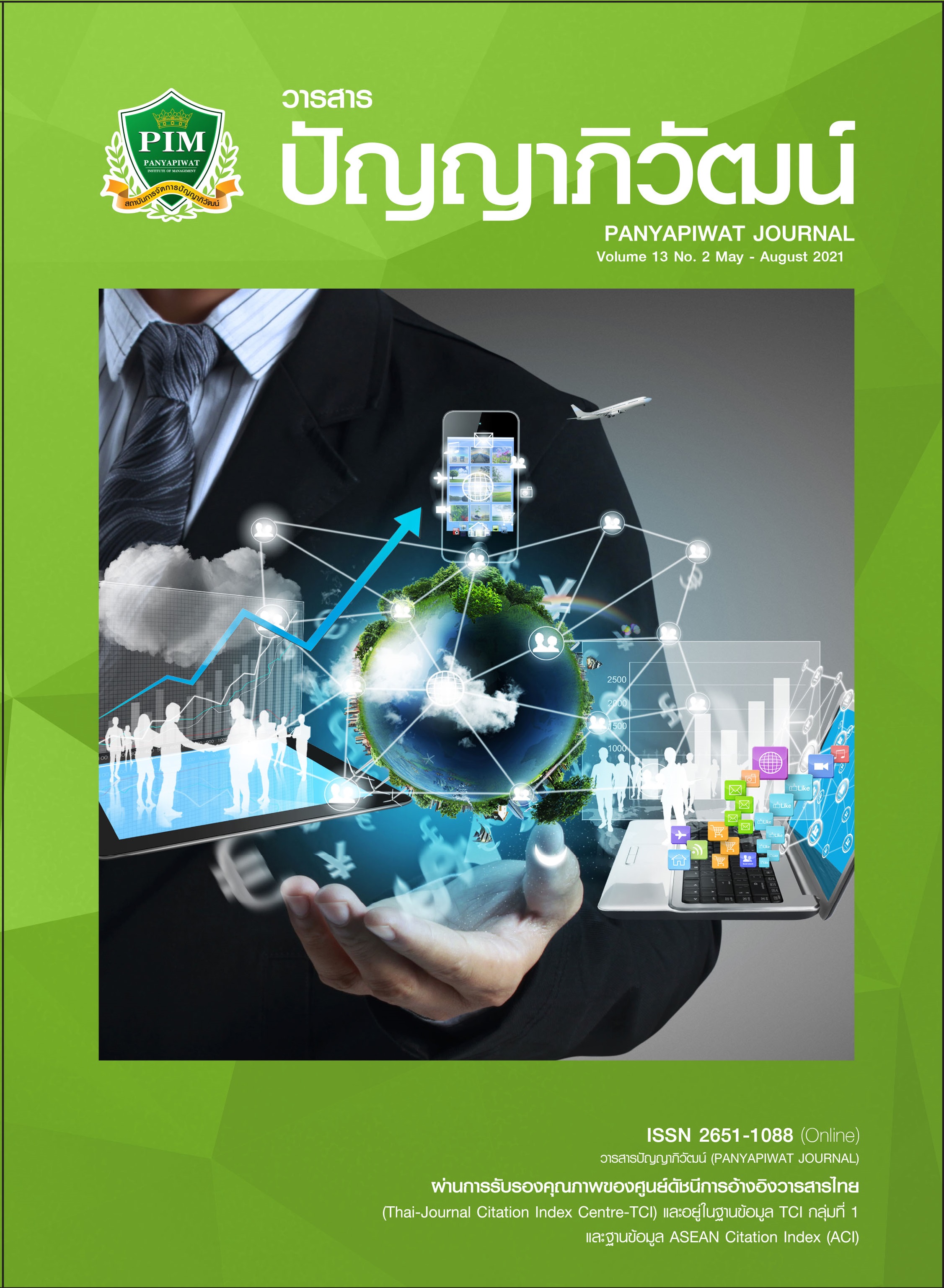พฤติกรรมการดูแลเด็กก่อนวัยเรียนด้วยสื่อดิจิทัลในศตวรรษที่ 21 ของผู้ปกครอง ในเขตภาคตะวันออก
Main Article Content
บทคัดย่อ
การวิจัยนี้มีวัตถุประสงค์เพื่อวิเคราะห์ 1) ปัจจัยทางประชากรศาสตร์ของผู้ปกครองที่มีผลต่อพฤติกรรมการใช้งานสื่อดิจิทัลและผลกระทบสำาหรับเด็กก่อนวัยเรียน 2) พฤติกรรมการดูแลเด็กก่อนวัยเรียนด้วยสื่อดิจิทัลในศตวรรษที่ 21 ของผู้ปกครอง กลุ่มตัวอย่างคือ ผู้ปกครองที่อยู่ในจังหวัดจันทบุรีและตราด จำานวน 400 คน เครื่องมือที่ใช้ในการวิจัย ได้แก่ แบบสอบถามและแบบสัมภาษณ์ โดยนำาข้อมูลมาวิเคราะห์ด้วยสถิติค่าร้อยละ และค่าเฉลี่ย การเปรียบเทียบความแตกต่างเป็นรายคู่ และการวิเคราะห์ความแปรปรวนทางเดียว ผลการวิจัยพบว่า การวิเคราะห์พฤติกรรมการใช้งานสื่อดิจิทัลของเด็กก่อนวัยเรียน ผู้ปกครอง ส่วนใหญ่ให้การดูแลระหว่างเด็กใช้สมาร์ทโฟนอยู่เสมอ บางครั้งมีการตั้งคำาถามจากเนื้อหาในสื่อดิจิทัลเพื่อทบทวนกับเด็ก บุตรหลานมีการร้องขอเข้าถึงสื่อดิจิทัลเป็น 1-3 ครั้งต่อวัน ความคิดเห็นจากผู้ปกครองคิดว่าเด็กเสพติดสื่อดิจิทัลในระดับปานกลาง และให้ใช้สื่อดิจิทัลเป็นเวลา 1-2 ชั่วโมงต่อวัน ผู้ปกครองนิยมให้เด็กใช้สื่อดิจิทัลในเวลาว่างทั่วไป สื่อดิจิทัลที่ได้รับความนิยมมากที่สุดคือ ยูทูป การวิเคราะห์พฤติกรรมการดูแลเด็กก่อนวัยเรียนด้วยการทดสอบสมมติฐานพบว่า พฤติกรรมการดูแลระหว่างเด็กใช้สมาร์ทโฟน การตั้งคำาถามจากเนื้อหาในสื่อดิจิทัลเพื่อทบทวนกับเด็ก การตรวจสอบสื่อดิจิทัลที่เหมาะสมสำาหรับบุตรหลาน และการกำาหนดระยะเวลาการให้เด็กใช้สื่อดิจิทัลมีความสัมพันธ์ต่อความแตกต่างทางประชากรศาสตร์ของผู้ปกครอง อย่างมีนัยสำาคัญทางสถิติ
ที่ระดับ 0.05 ผลการวิจัยเชิงคุณภาพพบว่า ผู้ปกครองส่วนใหญ่เห็นประโยชน์ของสื่อดิจิทัลเพื่อช่วยเพิ่มทักษะความรู้และพัฒนาความคิดให้เด็กก่อนวัยเรียน สื่อดิจิทัลทำาให้เด็กก่อนวัยเรียนมีความสนใจอยู่เฉยได้แต่ต้องควบคุมดูแลอย่างใกล้ชิด ผู้ปกครองควรกำาหนดให้เด็กใช้เวลากับสื่อดิจิทัลเคลื่อนไหวไม่เกิน 15 นาที เนื่องด้วยปัญหาสุขภาพสายตาและสมาธิสั้นของเด็กที่ใช้สื่อดิจิทัล และสมาร์ทโฟนมากเกินไป
Article Details
“ข้าพเจ้าและผู้เขียนร่วม (ถ้ามี) ขอรับรองว่า บทความที่เสนอมานี้ยังไม่เคยได้รับการตีพิมพ์และไม่ได้อยู่ระหว่างกระบวนการพิจารณาลงตีพิมพ์ในวารสารหรือแหล่งเผยแพร่อื่นใด ข้าพเจ้าและผู้เขียนร่วมยอมรับหลักเกณฑ์การพิจารณาต้นฉบับ ทั้งยินยอมให้กองบรรณาธิการมีสิทธิ์พิจารณาและตรวจแก้ต้นฉบับได้ตามที่เห็นสมควร พร้อมนี้ขอมอบลิขสิทธิ์บทความที่ได้รับการตีพิมพ์ให้แก่สถาบันการจัดการปัญญาภิวัฒน์หากมีการฟ้องร้องเรื่องการละเมิดลิขสิทธิ์เกี่ยวกับภาพ กราฟ ข้อความส่วนใดส่วนหนึ่งและ/หรือข้อคิดเห็นที่ปรากฏในบทความข้าพเจ้าและผู้เขียนร่วมยินยอมรับผิดชอบแต่เพียงฝ่ายเดียว”
เอกสารอ้างอิง
Announcement of the Office of the Prime Minister concerning of the Announcement on National
Strategy (2018-2037). (2019, 18 April). Royal Thai Government Gazette. Vol. 136. Pt. 51A. pp. 1-2.
Ante-Contreras, D. (2016). Distracted Parenting: How Social Media Affects Parent-Child Attachment. The Degree of Master of Social Work, Department of School of Social Work, CSUSB Scholar Works.
Chiong, C. & Shuler, C. (2010). Learning: Is There an App for That? Investigations of Young Children’s Usage and Learning with Mobile Devices and Apps. New York, NY: The Joan Ganz Cooney Center at Sesame Workshop.
Council on Communication and Media. (2016). Media Use in School-Aged Children and Adolescents. Pediatrics, 138(5), 1-6. doi: 10.1542/peds.2016-2592
Coyne, S. M., Radesky, J., Collier, K. M., Gentile, D. A., Linder, J. R., & Rogers, J. (2017). Parenting and Digital Media. Pediatrics, 140(s2), 112-116. doi: 10.1542/peds.2016-1758N
Eampracha, A. (2014). Development of Human. Retrieved August 30, 2019, from http://www.educbkkthon.com/blog/apsornsiri
Ellias, N. & Sulkin, I. (2017). YouTube Viewers in Diapers: An Exploration of Factors Associated with Amount of Toddlers’ Online Viewing. Cyberpsychology: Journal of Psychosocial Research on Cyberspace, 11(3), Article 2. doi: 10.5817/CP2017-3-2
Hall. M, Nix, I., & Baker, K. (2013). Student Experiences and Perceptions of Digital Literacy Skills Development: Engaging Learners by Design? Electronic Journal of e-Learning, 11, 207-225.
Keane, D. T. (2012). Leading with Technology. The Australian Educational Leader, 34(2), 44.
Likert, R. (1961). New Patterns of Management. New York: McGraw-Hill.
National Statistical Office. (2016). Number of Children Born Separating of Ages, Zone and Province
A.D. 2006 - 2015. Retrieved August 30, 2019, from http://service.nso.go.th/nso/web/statseries/statseries01.html [in Thai]
Nikken, P. & Opree, S. (2018). Guiding Young Children’s Digital Media Use: SES-Differences in Mediation Concerns and Competence. Journal of Child and Family Studies, 27, 1844-1857. doi: 10.1007/s10826-018-1018-3
Parsons, T. (1977). Social Systems and the Evolution of Action Theory. New York: The Free Press.
Patanapongton, J. & Keawkangkun, W. (2017). Factors Effecting to Child Development in Thailand in 2017 (Research Report). Department of Health. [in Thai]
Renk, K., Roberts, R., Roddenberry, A., Luick, M., Hillhouse, S., & Phares, V. (2003). Mother, Fathers, Gender Role, and Time Parents Spend with Their Children. Sex Roles, 48(7/8), 305-315.
Ruengrong, P., Jiravarapong, B., Manyum, W., Somyaron, W., Muendet, S., & Srisurat, C. (2014). Educational Technology VS Thai Teacher in 21st Century, Panyapiwat Journal, 5(Special ), 195-207. [in Thai]
Sahamaytaphut, N. (2012). Tablet and the Future of the Nation. Retrieved August 30, 2019, from http://rajanukul.go.th/new/index.php?mode=maincontent&group=225&id=148&date_start=&date_end [in Thai]
Sungkawadee, K. (2019). The Result of the Use of Blended Innovation to Promote DMAIC Information Literacy in 21st Century for Higher Education Students. Panyapiwat Journal, 12(1), 291-303. [in Thai]
Tancharoenwong, A. S., Pakdeeronachit, S., & Svetthitikun, Y. (2018). Screen Behaviour of Thai Toddlers Aged 0-3 years in Bangkok. Journal of Social Communication Innovation, 6(2), 60-69. [in Thai]
Trakoonpuksrirood, W. (2014). Tablets and Smartphones May Affect the Emotional and Social Development of Children. Retrieved August 30, 2019, from http://www.siamintelligence.com/smartphones-damage-social-development [in Thai]
Wongkitrungruang, W. & Jittarit, A. (2011). Future Skills: the 21st Century Education. Bangkok: Open World. [in Thai]
Wongyai, N. (2017). A Guide to Developing Digital Literacy Skills of Digital Native. Veridian E-Journal, 10(2), 1630-1642.
Yamane, T. (1967). Taro Statistic: An Introductory Analysis. New York: Harper & Row.


